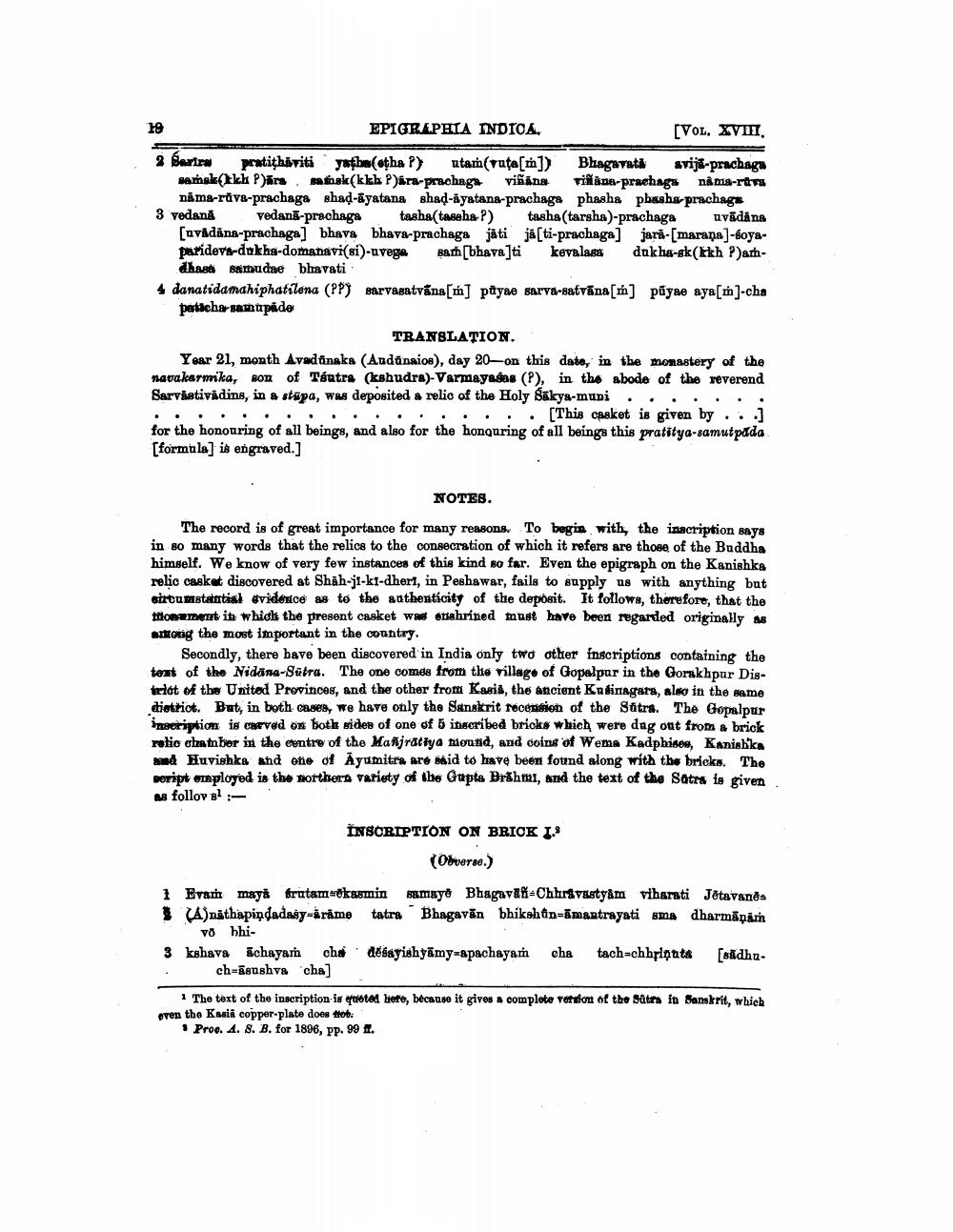________________
EPIGRAPHIA INDICA.
[VOL. XVIII.
2 Barira
pratiṭhäviti yatha(etha ?) utah(rata[th])
Bhagavata avija-prachag samsk(kkk Pära samnak (kkh ?)ara-prachaga viñana villana-prachaga nama-rava nama-riva-prachaga shad-ayatana shad-ayatana-prachaga phasha phasha-prachaga 3 vedană vedana-prachaga tasha(taseha?) tasha (tarsha)-prachaga uvādāna [uvadana-prachaga] bhava bhava-prachaga jäti ja [ti-prachaga] jara-[marana]-soyaparideva-dukha-domanavi(si)-uvega Math[bhavati kevalasa dukha-sk(kh ?)arhdhase samudae bhavati
18
4 danatidamahiphatilena (PP) mevastvina[th] pityse sarra-catriza[th] püyse ayn[]-cha paticha-samupäde
TRANSLATION.
Year 21, month Avadanaka (Audünaios), day 20-on this date, in the monastery of the navakarmika, son of Tsutra (kshudra)-Varmayasas (?), in the abode of the reverend Sarvästivādins, in a stupa, was deposited a relic of the Holy Sakya-muni
[This casket is given by...] for the honouring of all beings, and also for the honouring of all beings this pratitya-samut pada [formula] is engraved.]
NOTES.
The record is of great importance for many reasons. To begin with, the inscription says in so many words that the relics to the consecration of which it refers are those of the Buddha himself. We know of very few instances of this kind so far. Even the epigraph on the Kanishka relic casket discovered at Shah-ji-ki-dheri, in Peshawar, fails to supply us with anything but sircumstantial evidence as to the authenticity of the deposit. It follows, therefore, that the tonement in which the present casket was enshrined must have been regarded originally as among the most important in the country.
Secondly, there have been discovered in India only two other inscriptions containing the text of the Nidana-Sutra. The one comes from the village of Gopalpur in the Gorakhpur District of the United Provinces, and the other from Kasia, the ancient Kasinagara, also in the same district. But, in both cases, we have only the Sanskrit recension of the Sutra. The Gopalpur inscription is carved on both sides of one of 5 inscribed bricks which were dag out from a brick retic chamber in the centre of the Manjratiya mound, and coins of Wema Kadphises, Kanishka and Huvishka and one of Ayumitra are said to have been found along with the bricks. The script employed is the northern variety of the Gupta Brahmi, and the text of the Satra is given as follov sl:
INSCRIPTION ON BRICK Į.
(Obverse.)
1 Evam maya frutamokasmin samaye Bhagavaй-Chhravastyam viharati Jētavanes (A)nathapindadasy-arame tatra Bhagavan bhikshan-amantrayati sma dharmāņāṁ vo bhi
3 kshava achayam cha desayishyamy-apachayam
cha tach-chhriputs [sadhu
ch-asushva cha]
1 The text of the inscription is quoted here, because it gives a complete version of the Sutra in Sanskrit, which even the Kasia copper-plate does not.
Proo. 4. 8. B. for 1896, pp. 99 f.




